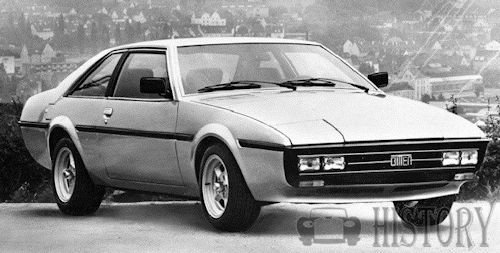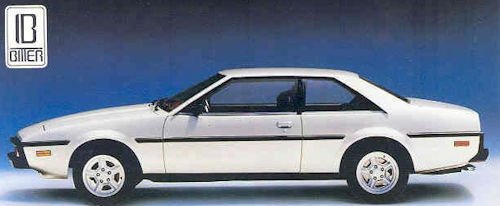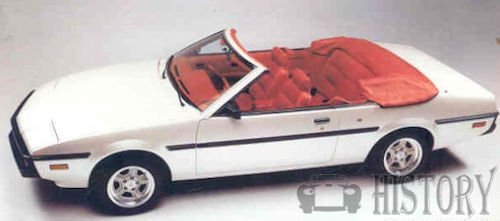Bitter SC Car range
 |
|
| Bitter SC | |
|---|---|
| Production period: | 1981-1989 |
| Body versions : | Coupé , Cabriolet ,Sedan |
| Engines: | 3.0-3.9 liters (132-154 kW) |
| Length: | 4910-5060 mm |
| Width: | 1820 mm |
| Height: | 1350-1370 mm |
| Wheelbase : | 2683-2683 mm |
| Curb weight : | 1515-1635 kg |
The Bitter SC was the second model of the German manufacturer Bitter . It replaced the Bitter CD and was also based on mass production technology from Opel. The official presentation of the Bitter SC Coupé took place in the spring of 1980 on the occasion of the Grand Prix of the Formula 1 of Monaco , where it was used as a safety car .
The SC was produced from the beginning of 1981 and was available over the years in three body versions. In addition to the coupe, the volume model of the series, from the spring of 1983, a convertible and from late summer 1985, a four-door sedan sedan called SC Sedan offered.
Until the discontinuation of production in the late autumn of 1989, a total of 488 copies of the Bitter SC series were produced. The indirect successor should be the prototype Type 3.
History
The concept
In the SC Erich Bitter repeated the conceptual approach of the CD. Again, he created an elegantly designed vehicle with Italian-style body and unproblematic mass production technology. Erich Bitter explained his preference for mass production technology with the following words: "I want my car to start without problems even after five days in the mountains after I have parked it in the mountains and gone skiing. What is the point of having a car that does not drive in difficult conditions? "
In the case of the SC withdrew a resort to the sovereign motorized Diplomat technology: Opel had ceased production of the great diplomat in the summer of 1977. Although Bitter still had a number of diplomatic parts, due to which the continuation of the production of the CD was secured for another year; after that, however, the idea of a new Bitter model was inevitable. Back in the spring of 1977, Bitter was able to secure the right to use Opel Senator A , which had not even been presented at the time, as the technical basis for a new coupé. The advantage of this technique was its reliability and easy availability.
In terms of sportiness and exclusivity, she remained well behind the diplomat's eight-cylinder. Some observers considered the technique downright bourgeois and saw it as a major reason for the low prevalence of SC .
Unlike the CD, Bitter received no significant support from Opel except for the provision of the technical components. Bitter therefore had to carry out the development work on his own; It lasted two years and cost about 8 million German marks . Bitter was only able to do this by investing externally, namely by a Swiss industrialist.
Body
Erich Bitter initially thought, as in the case of the CD only a coupe variant. The first draft of the body came from Erich Bitter himself. Unlike the CD of the new SC had no hatchback, but a saloon with a distinctive trapezoid line clear in the by Pininfarina -designed Ferrari 400 remembered and a similar elegance in appearance and in detail had. Like this, the Bitter SC had folding headlights. Bitter's design was then revised by Opel designers Henry Haga and Georges Gallion. The details of the design and the bodywork were finally by Giovanni Michelotti executed in Turin. All in all, the new car used many Opel parts, which were certainly not readily apparent on the exterior. Attachments such as lights and door handles came from mass producers, the rear lights, for example, were taken over by the Lancia Beta Montecarlo (and not, as often suspected, the Fiat X1 / 9 ), the front light units of the Ferrari Mondial .
BODY: All steel load bearing body shell—5 person seating capacity—front and rear zones computer programmed for controlled impact absorption—integrated roll-over bar—recessed safety door handles—laminated windscreen, heated rear window—wide rubber side protection mouldings—noise insulated interior—integral rear towing hook—vertically stored spare wheel in side of boot.
RUST PROTECTION: Body surface cataphoresed as well as manually primer coated and painted—underbody protected by p, V.C. coating, including wheel arches and at sides of floor panels.
LIGHTING: Four halogen headlamps with low/ high beam. Integrated direction indicators combined with warning lamps—variable intensity instrument lighting—door courtesy switch controlled interior lighting with additional switch on instrument panel; two additional lamps in the rear passenger compartment.
Technology
In the early development phase, there were plans to equip the SC with an eight-cylinder engine as before. As drive sources engines of Lamborghini - here the 3.5-liter eight-cylinder engine from the Urraco - and Holden were considered and certainly tested on test benches. However, this idea failed because of the noise and emissions performance of large engines . Instead, Bitter made extensive use of the drive technology of the Opel Senator and the Opel Monza . The car was initially with a not significantly changed six-cylinder in- line engine equipped with a capacity of 2968 cc from the Senator. In the last model years, he was also equipped with a 3848 cc in-line six-cylinder Tuner Mantzel. Individual vehicles eventually received a four-wheel drive from Ferguson.
PERFORMANCE:
3.0 Litre Engine
Maximum Speed . Manual Transmission 133 m.p.h. 0-62 m.p.h 8.5 seconds
Maximum Speed Automatic Transmission 130 m.p.h. 0-62 m.p.h 9.4 seconds
3.9 Litre Engine
Maximum Speed Manual Transmission 142 m.p.h. 0-62 m.p.h 7.6 seconds
Maximum Speed Automatic Transmission 137 m.p.h. 0-62 m.p.h 8.5 seconds
EQUIPMENT
Central door locking system, tachometer, electronic 2 speed windscreen wiper with interval wiping—ANindscreen washer electric pump and contact—cigar lighter and ashtray in middle of instrument panel—two adjustable upholstered sun visors—safety interior mirror with anti-glare position—remote control mirrors, right and left (electric)—large console on centre tunnel with storage space and upholstered arm rest—arm rests with integral grap handles on roof frame—colour co-ordinated velour headliner—velour carpet—boot Compartment carpeted in velour—boot illumination—engine compartment illumination—heat absorbing tinted glass standard—electrically operated windows—light alloy wheels.
Standard equipment: Cruise control; Philips Cassette/ Radio with 4 speakers (2 front, 2 rear) automatic antenna, wooden panels for switch, and centre console.
Option: Electric Sun-roof. WARRANTY: 2 years or 24,000 miles.
INSTRUMENTS: Upholstered instrument panel—instrument cluster—speedometer with trip distance temperature gauge—oil pressure gauge—control lights for high beam—direction indicators—hazard warning flashers and handbrake (combined with clutch warning and brake system warning clock. Switches for: heated rear window (with control lamp), and provisions for installation of switches for fog lamps, heated seat—combined switch for headlamps, instrument and interior lamps—switch for infinitely variable instrument lighting—illuminated switch group for fresh air and heating—pressure switch for hazard warning lights on steering column—combination lever on steering column for directional indicator, high beam, windscreen wiper and windscreen washer—starter switch combined with steering and ignition lock on steering column.
HEATING AND VENTILATION: Multi-adjustable ventilation and heating systems (accurate temperature control through fresh air blending) with four speed radial blower and warm air outlets for windscreen and footwells. outlets (variable in direction and airflow) in upper part of instrument panel for ventilation Of side windows and interior, as well as two adjustable fresh air outlets in centre of instrument panel—additional leg room heating in rearcompartment. Standard Equipment: air conditioning.
SEATS: Standard Equipment: Half leather upholstery; Anatomically correct, fully reclining front seats with headrests (foam rubber with spring base) mounted on ball-bearing runners, infinitely variable seat height adjuster, storage pockets on back of front seats—centre console with upholstery arm rest and storage box—storage pockets in the doors—folding centre rear seat armrest—three point seat belts front and rear.
The production
As with the Bitter CD, the production of the SC was largely outsourced. According to the common concept for small series manufacturers, the body was to be manufactured in an external factory before being transported to Bitter in Schwelm and assembled there with drive technology. At the CD the body had been made by Baur .
However, this path was eliminated for the SC. After the last CD had left the band at Baur at the end of 1979, Baur had found an alternative with the production of the BMW M1 , which was so exhausted that there was no capacity left to build the new Bitter. Erich Bitter therefore deviated to northern Italy, where for decades there were a large number of small, independent bodyworks, which made for other vehicle manufacturers either by hand or in small series superstructures. First, the choice fell on the Carrozzeria OCRA in Turin , a relatively young company with little experience. Between early 1981 and early 1982, OCRA introducedA total of 79 bodies ago, the overall were of poor quality. Given the use of Soviet recycled sheet metal, the cars were extremely rust-prone; Some vehicles began rusting just a few months after delivery.
In the spring of 1982, Bitter terminated the contract with OCRA . The production was then relocated to the also based in Turin Carrozzeria Maggiora , a company as experienced as well as renowned, which at that time also produced bodies for Maserati and Bristol . Individual vehicles are said to have been completed at Zagato . The leather for the interior was sourced from SALT in Turin . By the end of 1983, the vehicles were completed at Bitter in Schwelm. However, the small plant soon came to its limits, because there usually only one car per week could be completed.
In view of the planning for an expansion of production, Bitter finally found the opportunity to complete the cars at Steyr Daimler Puch in Graz . There, about three to four cars were produced weekly by the end of 1989 .
Body versions
Coupe
The SC Coupe came in spring 1981 as the first version on the market and thus represented the volume model of the series dar. With 461 manufactured copies, it was also the most common variant.

Cabriolet
In the spring of 1983, the series was supplemented by the SC Cabriolet. The hood was based on a design that had developed the supplier Keinath for a limited series of 144 convertibles based on the Opel Monza.
By the end of 1989, only 22 convertibles.

Sedan
The Sedan supplemented from late summer 1985, the model range. This was a four-door limousine sedan, which was designed primarily for sale in the US . The vehicle was based on an extended chassis.
The first prototype was created in 1984. The SC Sedan was an extended version of the coupe dar. Drive technology and roof height remained unchanged. The prototype was powered by the 3.0-liter six-cylinder Opel Senator and had a manual five-speed gearbox. The production cars, which were manufactured from mid-1985, deviated in some details from this prototype. All production vehicles had a higher roof. They were powered by the 3.9-liter mantzel engine and all had an automatic transmission.From SC Sedan until the middle of 1988, only four production vehicles were produced. Three of them still exist; they are in the USA. The prototype today belongs to a Dutch collector .

Technical
-
TECHNICAL SPECIFICATIONS BITTER SC
ENGINE: 3.0 litre (30 2968 cc. B.H.P.: 180 SAE Net (127kw) at 5,800 r.p.m., Max Torque: 173 lbs/ ft at 4,500 r.p.m.,
Compression Ratio: 9.4 to l.
Six cylinder—four cycle—in line; Main Bearings: 7 , overhead roller chain driven camshaft, hydraulic tappets, Fuel Injection; Bosch L-Jetronic
Cooling System; Pressure-type liquid cooling, Radiator with Visco-Drive-Fan; Cooling System Capacity: 10.2 litres; Lubrication system with seperate motor oil cooler and with seperate transmission oil cooler (only automatic transmission);
Engine oil refill, with filter: Capacity 6.0 litres; Fuel Tank Capacity: 16 (73) galls, (litres);Electrical System: Battery voltage: 12; Battery capacity; 55 Amp/ h; Alternator; 960 W; Transistorized breakerless ignition system, automatic ignition advance by centrifugal force and vacuum, spark plugs AC 42-6 FS, 3.9 litre (39 3848 cc, B.H_P: 210 SAE Net 1(154kw) at 5, 100 r.p.m., Max Torque: 263 lbs/ft at 3,400 r,p.m.,
Compression Ratio: 9.5 to I All other data as per 3.0 litre engine.
GEARBOX: (a) Automatic transmission (hydraulic three-element torque converter) and an automatically shifting three-speed planetary gear set with parking lock. Ratios; 1st gear 2.40; l, 2nd gear I .48: l, 3rd gear 1.00: l, Reverse I .92: l;
(b) Fully synchronised five speed transmission, single plate dry disc clutch with diaphragm (Bellevue-Type) spring. Ratios; 1st gear 3.822, 2nd gear 2.223, 3rd gear I .398, 4th gear 1.000, 5th gear 872, Reverse 3.705; Final drive ratio; 3.45: l; Optional limited slip differential gear (40% locking ratio); Two piece tubular propeller shaft.
CHASSIS: Front Axle; Independent with McPherson strut, control arm with tension rod, torsion bar stabilizer; Rear Axle; Independent with semi-trailing arms, double conical shaped miniblock coil springs with progressive rate—torsionbar stabilizer.
STEERING: Power steering,energy absorbing steering column with mesh section, telescoping steering shaft and tear-off support, height adjustable four spoke padded safety steering wheel: steering Ratio: 16.0: I .
BRAKES: Hydraulic dual circuit 4 wheel brake booster—brake pressure regulator in rear circuit; 10.7 in (272 mm) vented discs front, I I _O in (279 mm) discs rear power asst.
WHEELS: Light alloy sports wheel: Front 7] x 15, Rear 8Jx 15.
TVRES: Pirelli low profile: Front 215/60 VR 15, Rear 235/55 VR 15.
DIMENSIONS, WEIGHTS: Length: 2 door: 193.3 in (491 Omm), 4 door: 199.0 in (5055 mm), Width 7 1.7 in (1820 mm), Height 53. I in (1350 mm);
Wheelbase 105.6 in (2683 mm); Track, front: 57.8 in (1467 mm); Track, rear: 59.4 in (1508 mm); Curb Weight: 3417 lbs (1 550 kg); Permissible gross
weight (preliminary): 4345 lbs (1975 kg); Turning Circle Diameter: 35.4 ft (10.8 m).Performance
model top speed Acceleration 0 to 100 km / h Bitter SC 3.0 Coupe 215 km / h
210 km / h (automatic)8.6 seconds
9.6 seconds (automatic)Bitter SC 3.9 Coupe 230 km / h
220 km / h (automatic)7.6 seconds
8.6 seconds (automatic)Bitter SC 3.9 convertible 215 km / h
210 km / h (automatic)7.8 seconds
8.8 seconds (automatic)Bitter SC 3.0 Sedan 215 km / h
210 km / h (automatic)8.8 seconds
9.8 seconds (automatic)Bitter SC 3.9 Sedan 230 km / h
220 km / h (automatic)7.8 seconds
8.8 seconds (automatic)
Service
-
Bitter SC Maintenance and Service Guide (1981-1989)
3.0L
fuel: 98 oct petrol
engine oil change:10.8 imp pt, 12.7 US pt, 6 1, SAE 20W-50, change every 3,100 miles, 5,000 km
gearbox 1.9 imp pt, 2.3 US pt, 1.1 1, SAE 80, no change recommended
final drive 2.5 imp pt, 3 US pt, 1.4 1,SAE 90, no change recommended
greasing: none
spark plug: AC 42-6 FS
valve timing: 320 900 720 500
tyre pressure: front 28 psi, 2 atm, rear 30 psi, 2.2 atm.
